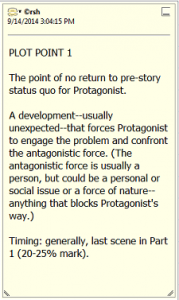The VISUAL TIMELINE Novel/Screenplay Structure
 The writer’s VISUAL TIMELINE [screenshot left (resized to fit) with Plot Point 1 pop-up Note] gives you a unique edge in writing your novel or screenplay. Open it side-by-side with your manuscript to stay on track and see exactly where you are and where you need to go at any given place in your story.
The writer’s VISUAL TIMELINE [screenshot left (resized to fit) with Plot Point 1 pop-up Note] gives you a unique edge in writing your novel or screenplay. Open it side-by-side with your manuscript to stay on track and see exactly where you are and where you need to go at any given place in your story.
Horizontal background lines unobtrusively line up page numbers with the recommended placement of the Parts and Elements of the classic story arc.
The Timeline is scaled to page numbers for both novel (double-spaced and single-spaced pages) and screenplay. It follows the classic 4-Part paradigm with 9 story Elements/Milestones. (The same as the 3-Act paradigm in which Act 2 consists of Parts 2 and 3.)
This tool opens in Adobe Reader (free pdf viewer) and other pdf viewers. The pop-up Notes are guidelines for each of the 4 Parts and 9 Milestones of story structure.
The Milestones are Opening, Hook, Inciting incident, Plot point 1 and 2, Pinch 1 and 2, Mid-point, and Resolution (climax and denouement).
In Adobe Reader:
To open a Note, move the mouse pointer over its icon or click on the icon. You’ll learn more features as you go. Other pdf readers may work differently.
Additionally, you can add your own pop-up Notes to the VISUAL TIMELINE. Just right-click anywhere on the page, then click on “Add Sticky Note” (Adobe Reader). This feature enables you to personalize the TIMELINE for each novel or screenplay you write.
The VISUAL TIMELINE is based on the time-honored structure of classic storytelling that captures and holds an audience–the backbone of the best novels and movies.
It’s a synthesis of the ideas of noted novel/screenwriting instructors distilled into one essential, visually-based tool.
“Structure is translation software for your imagination.”
—James Scott Bell
You might think of story structure as the ball field upon which your plot plays out. The VISUAL TIMELINE provides a clearly-marked field, showing you what milestones to hit and when to hit them, freeing you to play your best game.
What I wanted, but could not find anywhere, was an easy-to-follow visual diagram scaled to page numbers. So I did the legwork to learn what I needed and created it myself. The simplicity of its implementation is a reflection of the time and effort that went into it.
In original, organic fiction, the story itself dictates the page placement of the milestones, and this can vary from story to story. The important thing is that the milestones be present in the proper sequence.
The TIMELINE is an invaluable story-writing tool that sparks lots of excitement at writers’ gatherings–everyone wants it. Now I’m making it generally available for a nominal ten bucks (writers I’ve chatted with say this amount is a good sweet spot, the equivalent of buying me lunch).
